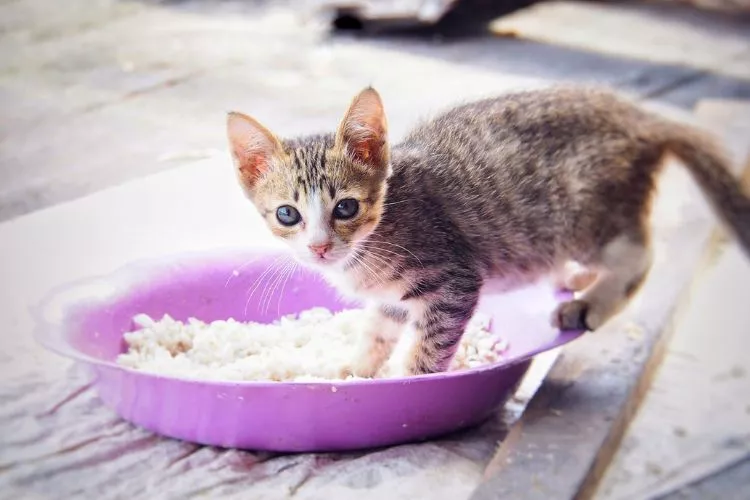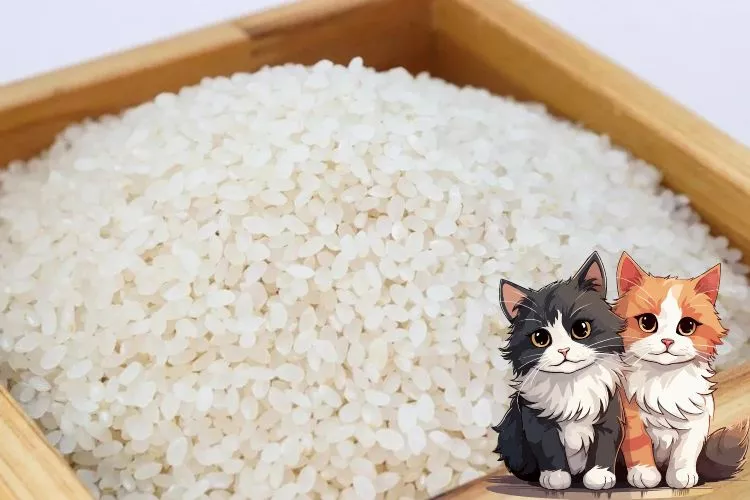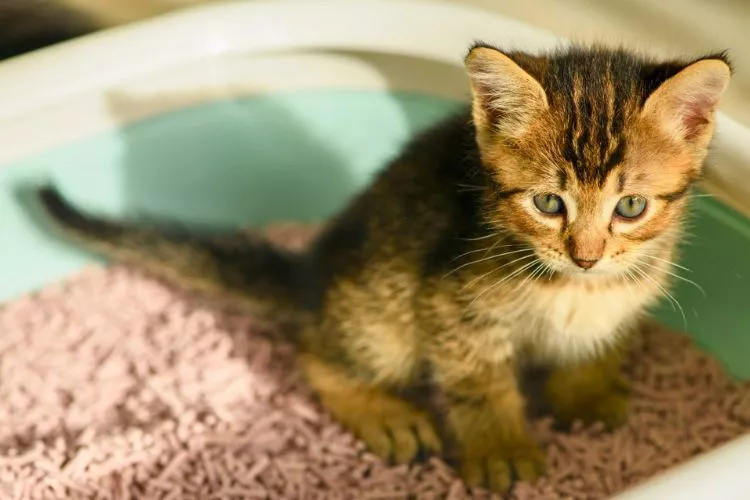Exploring alternative options for cat litter has become increasingly popular as pet owners search for economical, environmentally-friendly, and safe choices. Among these alternatives, rice has piqued the curiosity of many.
So, can you use rice as cat litter?
In this article, we’ll evaluate the viability of using rice as cat litter, delve into its potential pros and cons, and help you decide to maintain your feline friend’s comfort and well-being.

🐾 Can I use rice as cat litter?
Given its abundant availability and sustainable nature, the prospect of using rice as cat litter appears intriguing. However, there are several factors to consider before making this switch.
Firstly, rice has superb absorbency properties, potentially useful as a cat-litter medium. Raw rice can soak up urine, reducing odor to a certain extent.

Yet, there are notable downsides to utilizing rice as cat litter. Rice isn’t as dust-free as regular cat litter, potentially irritating your cat’s respiratory system.
It also lacks clumping properties, making cleanup more challenging and less sanitary as urine could soak to the bottom, promoting bacterial growth.
Furthermore, since rice is a food source, it could attract pests, increasing hygienic concerns around your home. Raw rice could potentially pose choking hazards if your cat accidentally ingests it.
Therefore, while rice might be a cost-effective and environment-friendly option, its drawbacks imply it may not be the best choice for all cat owners. Always prioritize your cat’s health, behavior, and preferences when considering alternative cat litters.
🐾 What can I use temporarily as cat litter?
It’s important to always have cat litter handy for your feline companion. However, there may be instances when you run out and can’t restock immediately.
In such cases, consider these temporary cat litter alternatives:
- Newspaper: Tear it into shreds and place it in the litter box. Newspaper is absorbent but doesn’t control odor and requires frequent changing.
- Sand: Mimics the outdoors, an option cats often naturally gravitate towards. It clumps naturally when wet and absorbs well. However, it can be dusty and doesn’t control odor effectively.
- Soil: Another option that simulates a natural outdoors environment. Choose garden soil free from fertilizers or pesticides. It doesn’t clump or control smell.
- Wood shavings or Sawdust: Wood is naturally absorbent and can help control odors due to its pleasant scent. Make sure it’s finely shaved to prevent splinters. However, it doesn’t clump, and sawdust can be dusty.
- Chicken Feed: Like wheat or corn-based litters, chicken feed is an effective temporary substitute. Your cat may not like the texture or smell, so monitor their reaction.
- Cornmeal or Polenta: It clumps slightly when wet, making cleaning relatively easy. However, its odor control is below average and it may attract pests.
- Grain-based litters: These are usually made from wheat or corn. They are biodegradable and can be flushed in small amounts. They offer some odor control and clumping ability.
Remember, these are temporary solutions. All have limitations in odor control, clumping, dust production, or attracting pests. Monitor your cat for any negative reactions or allergies when using these alternatives, and return to regular cat litter as soon as possible.
🐾 How to make cheap cat litter?
Creating your cat litter may not only be cost-effective but also allow you to use more environmentally friendly components.

Please note that observing your cat for any changes indicating discomfort or distaste for the homemade litter is crucial. Here’s how you can make cat litter at home:
Newspaper Litter
- Start by gathering old newspapers. The more, the better.
- Shred the newspapers into small strips. The smaller the pieces, the better it will absorb.
- Soak the shredded newspaper in warm water mixed with dish soap. The soap helps to remove the ink.
- After soaking, drain the mixture and rinse the paper until the water runs clean.
- Squeeze out any excess water and place the paper in a warm, dry place to completely dry.
- Once dry, it’s ready to use.
Wood Shavings Litter
- Locate a supply of wood shavings or sawdust. Make sure it’s hardwood and not from treated or toxic wood.
- Allow the shaving or sawdust to dry out completely.
- Once dry, put a layer in the litterbox.
- Keep an eye on dust levels; remember, this litter type doesn’t clump.
Sand and Baking Soda Litter
- Fill the litter box with sand until it’s about 2 inches deep.
- Add in one cup of baking soda and mix well. Baking soda is highly effective for odor control.
Remember, these home solutions may not provide all the benefits of commercial litters such as clumping and superior odor control, and always keep your cat’s comfort and safety as the priority.
🐾 Ran out of cat litter, what can i use?
If you’ve run out of cat litter, there’s no need to panic! There are several alternative options you can use temporarily.

- Shredded Newspaper: Shred newspaper into pieces and use it as a temporary litter. Before the rise of commercial cat litters, owners frequently used this method. However, it doesn’t control odor well, and you’ll need frequent replacements.
- Wood Shavings: Wood shavings or sawdust from untreated and non-toxic hardwood could be cat litter. However, ensure that it’s finely shaved to prevent any harm to your cat.
- Sand and Baking Soda: Mix sand with a cup of baking soda. The sand allows for a natural, comfortable feel while baking soda helps control odors.
Lastly, remember that these substitutes are just temporary solutions and may not provide the same comfort, odor control, or ease of use as conventional cat litters. It’s always best to transition back to regular cat litter when possible.
One key consideration is the sustainability aspect of rice. As an organic, biodegradable product, rice is generally more eco-friendly than traditional clay-based litters, which are often mined and contribute to environmental degradation.
If you are passionate about using sustainable materials in your home, rice may appear to be a natural alternative. It’s a renewable resource that decomposes more easily than synthetic litters, helping to reduce your ecological footprint.
However, it’s worth mentioning that rice’s eco-friendliness can be limited if not managed properly. For instance, it is still a food product that requires significant resources, such as water and energy, to cultivate and harvest.
So, while it is more sustainable than some other alternatives, it’s important to weigh its environmental impact against other natural litters like wood pellets or corn-based options, which might offer more comprehensive benefits for both your cat’s health and the planet.
Another consideration is the cost. While rice may be cheap or even free if you already have it in your pantry, it is still important to factor in the time and effort required to manage it effectively.
As mentioned earlier, rice doesn’t have clumping properties, which means you’ll need to change the litter more frequently to prevent bacterial build-up. Additionally, rice might not be as absorbent as some commercial cat litters, which could require more frequent replacements and lead to higher long-term costs.
Ultimately, rice could be a viable short-term alternative, especially for environmentally-conscious pet owners on a budget. However, it’s crucial to consider the practicality of the alternative, especially regarding your cat’s well-being and your own convenience.
Conclusion :
In summary, it is indeed possible to use rice as cat litter. Rice provides good absorbency and odor control, significantly reducing smells. Biodegradable, non-toxic, and affordable, it can be a solid eco-friendly choice.
However, there are substantial concerns regarding its safety for cats who might ingest the grains, leading to digestive issues.
Therefore, it’s vital to monitor your cat closely if you decide to make the switch.
Considering all aspects, rice could be a short-term solution in emergencies, but it might not provide the most efficient or safest option for everyday cat litter needs.
